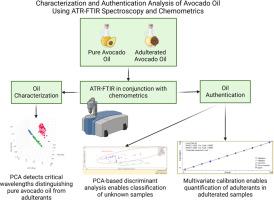Authentication of avocado oil mixed with cooking oils (branded and loose palm oil) utilizing fourier transform infrared spectroscopy in conjunction with chemometrics
IF 3.6
引用次数: 0
Abstract
Avocado oil (AVO) has become popular for its health advantages and culinary variety, while its elevated cost has rendered it susceptible to adulteration practices, frequently with less expensive edible oils such as palm oil. Attenuated total reflectance-fourier transform infrared spectroscopy (ATR-FTIR) in conjunction with chemometrics is a promising way to quickly, rapidly, and non-destructively detect AVO adulterated with branded palm oil (BPO) or loose palm oil (LPO). AVO can be distinctly categorized apart from BPO and LPO using FTIR analysis corroborated by principal component analysis (PCA). Principal component (PC) 1 is primarily influenced by absorption at a wavenumber of 1743 cm⁻¹, whereas PC2 is impacted by absorption at a wavenumber of 2953 cm⁻¹. With first derivative data and multiplicative scatter correction (MSC), multivariate calibration of principal component regression (PCR) was able to correctly predict the amount of BPO in AVO. This approach yielded root mean squared error of calibration (RMSEC) and root mean square error for prediction (RMSEP) values of 0.56 and 0.55, alongside coefficient of determination for the calibration and prediction model (R²-cal and R²-val) values of 0.9998 and 0.9999, respectively. In addition, PCR using first-derived data without MSC adjustment accurately quantified BPO levels in AVO, with RMSEC and RMSEP values of 0.60 and 0.61, respectively, along with R²-cal and R²-val values of 0.9998. This PCA-based discriminant analysis correctly separated the real AVO samples from the adulterated AVO samples with classification accuracies of 98.18 % for BPO and 100 % for LPO. This method may also be applicable further for detecting other possible edible oil adulteration, including soybean oil, rapeseed oil, and sunflower oil.

利用傅里叶变换红外光谱与化学计量学相结合,对牛油果油与食用油(品牌和松散棕榈油)混合进行认证
牛油果油(AVO)因其健康优势和烹饪多样性而广受欢迎,但其高昂的成本使其容易受到掺假行为的影响,经常与棕榈油等较便宜的食用油掺假。衰减全反射-傅里叶变换红外光谱(ATR-FTIR)与化学计量学相结合,是一种快速、快速、无损地检测掺假品牌棕榈油(BPO)或散装棕榈油(LPO)的AVO的有前途的方法。主成分分析(PCA)证实了FTIR分析,可以将AVO与BPO和LPO区分开来。主成分(pc1)主要受波数为1743 cm⁻¹的吸收的影响,而PC2主要受波数为2953 cm⁻¹的吸收的影响。利用一阶导数数据和乘法散点校正(MSC),主成分回归(PCR)多元校正能够正确预测AVO中BPO的含量。该方法的校正均方根误差(RMSEC)和预测均方根误差(RMSEP)分别为0.56和0.55,校正和预测模型的决定系数(R²-cal和R²-val)分别为0.9998和0.9999。此外,未经MSC调整的首次衍生数据的PCR准确定量了AVO中的BPO水平,RMSEC和RMSEP值分别为0.60和0.61,R²-cal和R²-val值为0.9998。基于pca的判别分析正确地分离了正品AVO和掺假AVO样品,BPO和LPO的分类准确率分别为98.18%和100%。该方法也可进一步用于检测其他可能的食用油掺假,包括大豆油、菜籽油和葵花籽油。
本文章由计算机程序翻译,如有差异,请以英文原文为准。
求助全文
约1分钟内获得全文
求助全文

 求助内容:
求助内容: 应助结果提醒方式:
应助结果提醒方式:


